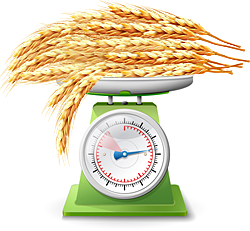Rye
Rye (lat. Secale cereale) is a grass, rye culture was known as the bronze age. In the world agriculture among cereals, rye takes area one of the last places. However, this does not give the right to consider culture in little demand because she is bred in many countries. Rye bread has a high calorific value, pleasant smell, good taste and contains the necessary proteins and vitamins.
The rye crop is an annual herb. As a forage plant is also cultivated cultivated perennial rye, obtained by crossing perennial with annual rye seed rye. In recent decades, breeders obtained by doubling the number of chromosomes in the cells of tetraploid rye, which form large grains (weight of 1 000 grains reaches 50-55 g), powerful, resistant to lodging straw.
Rye has a fibrous root system that penetrates to a depth of 2 m, so it easily tolerates light sandy soils, and due to the high physiological activity quickly learns of soil nutrients from insoluble compounds. The tillering node rye is formed on a little less depth from soil surface (1.7 to 2 cm)than wheat (2-3 cm). When the seed is placed in the soil deeply, rye lays two tillering node: first down, second and later - closer to the soil surface, which becomes the most important. The intensity of tillering at rye high enough - each plant produces 4-8 shoots, and under favorable conditions - up to 50-90.
The stalk at rye hollow, with 5-6 midasdemo, straight, separated cauline nodes. The top of the last internode pubescent. The height of the stem, depending on growing conditions and varieties ranges from 70 to 180-200 cm (average 80-100 cm).
Leaves linear, and together with the stem of PPE. The length of the leaf blade is 15-30 cm, width of 1.5 to 2.5, see the base of the plate is located a short tongue and a short glabrous or pubescent ears (auriculate), covering the stem. Leaf blade with the upper hand sometimes covered with hairs, which indicates the comparative resistance to moisture and adaptation to light sandy soils. The ligule and auricles in leaves of rye early wither and fall off.
The stem bears on the top of the inflorescence is one long, slightly drooping complex ear, under the ear stem is a little hairy. The ear consists of cellular, almost tetrahedral, nerazmenivaemosti rod and flat spikelets, sitting on the ledges of the rod and turned to him with the flat side. The ears of the two colors, and varieties triflorum trehtsvetkovaya. Spikelet scales lanceolate-subulate with one vein, shorter flowering scales, without awns and keel rough; outer flowering scale shorter than the upper, lanceolate, with a long awn, exceeding many times the spikelet, with five veins, on the edge and keel with a bristle-like cilia; inner flowering scale war, without awns, but with cilia at the top.
Stamens three, with long anthers protruding from the ear, the gynaecium with pinnate bipinnate stigma; wind pollination. Caryopsis oblong, slightly compressed laterally, with a deep groove in the middle; when ripe it falls out of the ear. Rye grain is different in size, shape and color. Its length is 5-10 mm, width of 1.5 to 3.5 mm, a thickness of 1.5-3 mm, Weight of 1000 grains in diploid rye - 20-35 g, tetraploid 30-35 grains Form elongate (length to width ratio of more than 3,3) or oval (length to width ratio of 3.3 or less) with prominent transverse wrinkles on the surface. Coloring distinguish grain white, green, grey, yellow, dark brown.
Biological features
In ontogenesis rye goes through the same phenological phases and stages of organogenesis, and wheat. Under identical conditions, the seedlings of rye appear faster on the 1...2 days. 1...2 days faster it starts and tillering. The tillering node is put closer to the soil surface (1,7...2.5 cm), more often two or three host plants. Tillering at rye occurs mainly in the autumn. In the spring she starts out in the tube through 18...20 days from the beginning of spring regrowth, and after 40...50 days ears. Flowering occurs within 7 to 12 days from the beginning of earing (in wheat after 4...5 days) and lasts 7...9 days. The milk stage comes in 10...14 days after flowering and lasts 8 to 10 days. 2 months after earing rye ripens. Then after maturing longer, so rye rarely grows in the ear. The mass of 1000 grains diploid varieties - 23...38 g, and tetraploid - 35...52,
To the conditions of cultivation of rye less demanding than wheat, especially to soils. She has a well developed root system that penetrates to a depth of 1.5 to 2 m and is able to absorb phosphorus and potassium of insoluble compounds. Rye is less sensitive to soil acidity. Grows well at pH 5,3 6,5.... Therefore, it can be grown on unsuitable for wheat podzolic soils.
But the best are fertile structural chernozems and gray forest soils of medium and light loamy texture. Do not grow well on heavy clays, waterlogged, saline soils. Rye is more winter hardy than other winter crops. Withstands temperature reduction at the level of the tillering node to minus 19...21°C. the Seeds begin to germinate at 0.5...2°C. Finishes the growing season in the fall and resume in the spring with 3...44°C.
Rye allogamous plant long day length. Pollen is transferred by air. Favorable for pollination is quiet warm weather with sufficient humidity. In hot weather with low humidity pollen loses its viability. Unfavorable for pollination is windy and rainy weather.
The rye crop is the only type of cultural rye, which is widely distributed in the global agriculture, including in Ukraine, as the most important food and fodder crop. View unites more than 40 varieties. All varieties of rye, which are widespread in Ukraine belong to the variety var Vulgate Körn. (Kolosova rod nelomky, outdoor flowering glume glabrous, grain open or semi-open).





